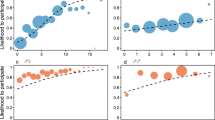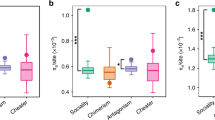Given the right circumstances, even an amoeba chooses to be altruistic towards its relatives.
Abstract
Kin recognition helps cooperation to evolve in many animals1, but it is uncertain whether microorganisms can also use it to focus altruistic behaviour on relatives. Here we show that the social amoeba Dictyostelium purpureum prefers to form groups with its own kin in situations where some individuals die to assist others. By directing altruism towards kin, D. purpureum should generally avoid the costs of chimaerism2,3 experienced by the related D. discoideum.
This is a preview of subscription content, access via your institution
Access options
Subscribe to this journal
Receive 51 print issues and online access
$199.00 per year
only $3.90 per issue
Buy this article
- Purchase on Springer Link
- Instant access to full article PDF
Prices may be subject to local taxes which are calculated during checkout

Similar content being viewed by others
References
Fletcher, D. J. C. & Michener, C. D. Kin Recognition in Animals (Wiley, Chichester, 1987).
Strassmann, J. E., Zhu, Y. & Queller, D. C. Nature 408, 965–967 (2000).
Foster, K. R., Fortunato, A., Strassmann, J. E. & Queller, D. C. Proc. R. Soc. Lond. B 269, 2357–2362 (2004).
Kessin, R. H. Dictyostelium — Evolution, Cell Biology, and the Development of Multicellularity (Cambridge Univ. Press, Cambridge, 2001).
Bonner, J. T. The Cellular Slime Molds 3rd edn (Princeton Univ. Press, Princeton, 1967).
Buss, L. W. Proc. Natl Acad. Sci. USA 79, 5337–5341 (1982).
Bonner, J. T. & Adams, M. S. J. Embryol. Exp. Morphol. 6, 346–356 (1958).
Kaushik, S., Katoch, B. & Nanjundiah, V. Behav. Ecol. Sociobiol. 59, 521–530 (2006).
Reeve, H. K. Am. Nat. 133, 407–435 (1989).
Crespi, B. J. Trends Ecol. Evol. 16, 178–183 (2001).
Author information
Authors and Affiliations
Corresponding author
Ethics declarations
Competing interests
The authors declare no competing financial interests.
Supplementary information
Supplementary Methods
(PDF 222 kb)
Rights and permissions
About this article
Cite this article
Mehdiabadi, N., Jack, C., Farnham, T. et al. Kin preference in a social microbe. Nature 442, 881–882 (2006). https://doi.org/10.1038/442881a
Received:
Accepted:
Published:
Issue Date:
DOI: https://doi.org/10.1038/442881a
This article is cited by
-
Multiple social encounters can eliminate Crozier’s paradox and stabilise genetic kin recognition
Nature Communications (2022)
-
Ten recent insights for our understanding of cooperation
Nature Ecology & Evolution (2021)
-
Kin discrimination allows plants to modify investment towards pollinator attraction
Nature Communications (2018)
-
Complex interactions underpin social behaviour in Dictyostelium giganteum
Behavioral Ecology and Sociobiology (2018)
-
Species recognition in social amoebae
Journal of Biosciences (2018)
Comments
By submitting a comment you agree to abide by our Terms and Community Guidelines. If you find something abusive or that does not comply with our terms or guidelines please flag it as inappropriate.



